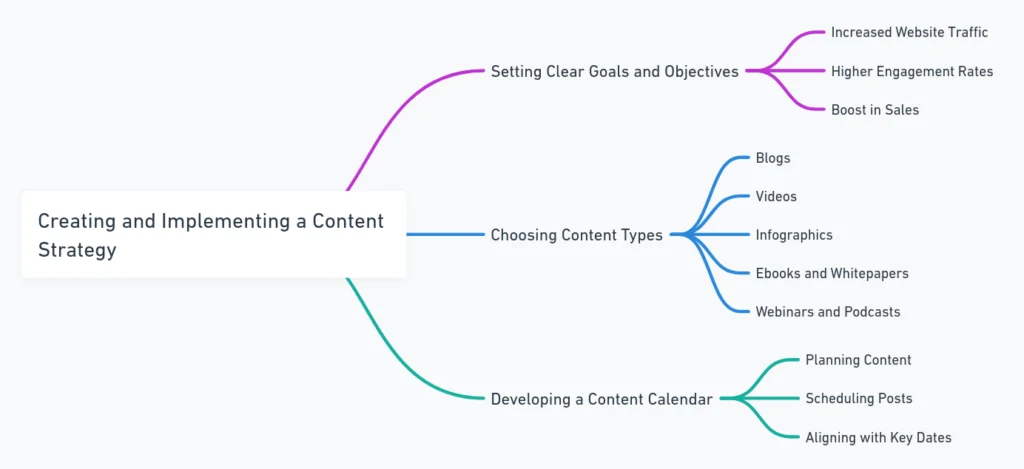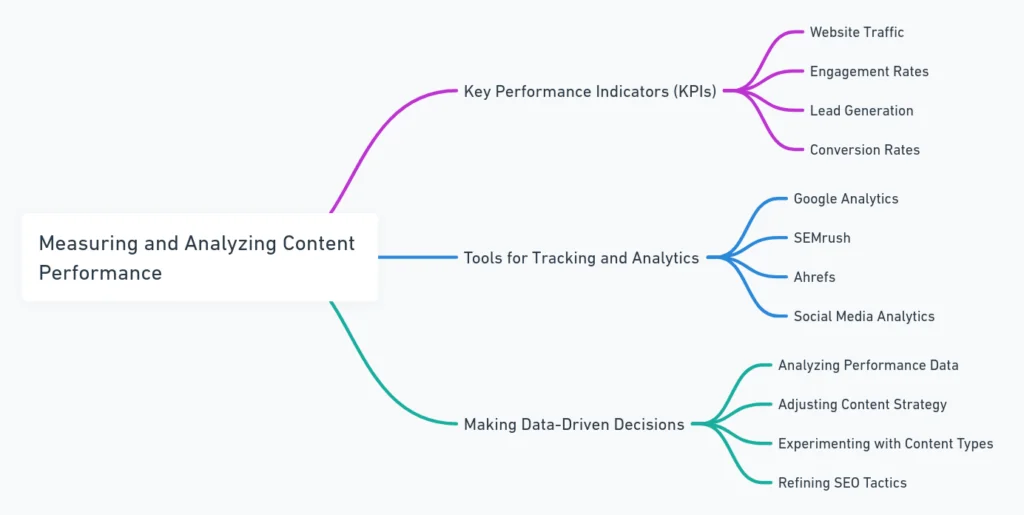Your Guide to Using Content Marketing to Drive Sales in 2024
In the digital age, content marketing has emerged as a cornerstone strategy for businesses aiming to drive sales and enhance customer engagement. Defined as the creation and distribution of valuable, relevant content to attract and retain a clearly defined audience, content marketing goes beyond traditional advertising by focusing on building trust and providing value. This guide delves into the strategies and best practices that can transform your content marketing efforts into a powerful sales-driving machine.
Understanding Your Target Audience

Before creating content, it’s essential to understand who your audience is. Research and data collection are critical in building detailed buyer personas. According to HubSpot, companies that use buyer personas see a 55% increase in website traffic and a 10% increase in leads. Start by analyzing your existing customer base, conducting surveys, and leveraging analytics tools to gather demographic and behavioral data.
Understanding Customer Pain Points
Identifying customer pain points involves analyzing feedback, conducting interviews, and studying market research. This step is crucial because content that addresses these pain points resonates more effectively with your audience. For example, if your business provides services like paper writings, understanding the specific struggles students face, such as time management or research difficulties, can help tailor your content to offer practical solutions. A Salesforce study found that 76% of consumers expect companies to understand their needs and expectations. You can create content that provides solutions by pinpointing these challenges, and positioning your brand as a valuable resource.
Mapping the Buyer’s Journey
Mapping the buyer’s journey helps in crafting content that meets the needs of your audience at different stages:
- Awareness Stage: At this stage, potential customers are identifying their problems. Content should aim to educate and inform.
- Consideration Stage: Here, prospects are evaluating options. Content should compare solutions and highlight benefits.
- Decision Stage: In the final stage, prospects are ready to make a purchase. Content should reinforce trust and provide clear calls to action.
Creating a Content Strategy

Setting Clear Goals and Objectives
Setting clear goals and objectives is the foundation of any successful content marketing strategy. Define what success looks like for your business. This could be increased website traffic, higher engagement rates, or, most importantly, a boost in sales. Align your content goals with your broader business objectives to ensure cohesion and direction.
Choosing Content Types
Diverse content types can cater to different audience preferences. Consider incorporating the following into your strategy:
- Blogs: Great for SEO and providing in-depth information.
- Videos: Engaging and easily digestible, videos are highly effective in conveying messages quickly.
- Infographics: These visually appealing formats are perfect for summarizing data and key points.
- Ebooks and Whitepapers: Offer in-depth insights and can be used as lead magnets.
- Webinars and Podcasts: Interactive formats that build authority and trust.
Developing a Content Calendar
A content calendar helps you plan and schedule your content in advance. It ensures consistency and allows you to align your content with key dates and events. Plan a mix of content types and topics to keep your audience engaged.
Content Creation Best Practices
A strong headline is crucial for grabbing attention. According to Copyblogger, 80% of people will read your headline, but only 20% will read the rest of the content. Crafting attention-grabbing headlines can significantly increase the chances of your content being read and shared. Use numbers, questions, and powerful words to make your headlines stand out.
Writing High-Quality Content
High-quality content is informative, valuable, and engaging. Ensure your content addresses the needs and interests of your audience. Keep it readable by using short paragraphs, subheadings, and bullet points. Take this blog from Netchex, for example. It’s in-depth yet precise, discussing everything you need to know about payroll management, from the information required to complete processing to what type of software to use. Engaging content keeps readers on your page longer, increasing the likelihood of conversions.
Using Visuals to Enhance Content
Visuals such as images, videos, and infographics can make your content more engaging and easier to understand. Use high-quality visuals that complement your content and help illustrate your points. To manage your growing library of images, videos, and graphics efficiently, consider choosing a DAM system to centralize assets, maintain brand consistency, and streamline collaboration across your marketing team.
To achieve high-quality visuals, you can explore infographics made with AI to present your points more effectively.
Incorporating SEO Techniques
Optimizing your content for search engines increases its visibility. Perform keyword research to identify terms your audience is searching for and incorporate these keywords naturally into your content. Follow on-page SEO best practices, such as using meta descriptions, alt text for images, and internal linking.
If you are hiring an SEO specialist, reviewing job-winning resume examples can help you spot candidates with a proven track record in improving search rankings.
Content Distribution and Promotion
Utilizing Social Media Platforms
Social media is a powerful tool for promoting your content. Choose the platforms where your audience is most active and share your content regularly. Use engaging captions, hashtags, and visuals to increase reach and engagement.
Leveraging Email Marketing
Email marketing allows you to reach your audience directly. Build and segment your email lists to send targeted content that resonates with different segments of your audience. According to DMA, email marketing has an average ROI of $42 for every dollar spent. Create effective email campaigns to nurture leads and drive sales.
Collaborating with Influencers
Influencer marketing can amplify your content’s reach. Identify relevant influencers in your industry and build mutually beneficial relationships. According to Influencer Marketing Hub, businesses earn an average of $5.20 for every $1 spent on influencer marketing. Collaborating with influencers can introduce your content to a broader audience and boost credibility. To ensure your efforts are paying off use an influencer tracking system that will help you monitor performance and make data-driven adjustments.
Paid Promotion Strategies
Paid promotions can accelerate the reach of your content. Explore options such as pay-per-click (PPC) advertising, sponsored social media posts, and native advertising. Implementing paid strategies ensures your content reaches a larger, targeted audience quickly.
Measuring and Analyzing Content Performance

Key Performance Indicators (KPIs)
Identifying relevant KPIs is essential for measuring the success of your content marketing efforts. Common KPIs include website traffic, engagement rates, lead generation, and conversion rates. Setting benchmarks helps track progress and make data-driven decisions.
Tools for Tracking and Analytics
There are several tools available to track and analyze content performance. Google Analytics is widely used for website analytics, while tools like SEMrush and Ahrefs provide insights into SEO performance. Social media platforms also offer built-in analytics to track engagement. Use these tools to gather data and identify areas for improvement.
Making Data-Driven Decisions
Analyzing performance data helps you understand what’s working and what’s not. Use insights from your analytics to adjust your content strategy. This might include tweaking your content calendar, experimenting with different content types, or refining your SEO tactics. Data-driven decisions lead to more effective content marketing and better results.
Successful Content Marketing Campaigns
Examining successful content marketing campaigns provides valuable insights. For instance, the “Share a Coke” campaign by Coca-Cola personalized their products, leading to a 2% increase in U.S. sales. To achieve similar success, partnering with digital marketing agency services can help craft targeted, personalized campaigns that truly resonate with your audience.
Industry-Specific Examples
Different industries have unique content marketing needs. In the tech industry, for example, IBM’s content marketing focuses on thought leadership and providing in-depth technical content. In the fashion industry, brands like Glossier use social media and user-generated content to build a community and drive sales.
Overcoming Common Challenges
Maintaining Consistency
Consistency is crucial for building trust and keeping your audience engaged. Develop a content calendar and stick to it. Regularly publishing high-quality content ensures your brand remains top-of-mind for your audience.
Staying Relevant and Up-to-Date
Keeping up with industry trends and updating your content regularly is essential. According to a study by HubSpot, updating old blog posts with new information can increase organic traffic by up to 106%. Stay informed about the latest trends and continually refresh your content to maintain its relevance.
Handling Content Saturation
In a crowded content landscape, standing out can be challenging. Focus on creating high-quality, unique content that addresses your audience’s specific needs. Use storytelling to make your content more engaging and relatable. Differentiation through unique insights, expert interviews, and exclusive data can also help your content stand out.
Future Trends in Content Marketing
Emerging technologies such as artificial intelligence (AI) and machine learning are transforming content marketing. AI can assist in content creation, personalization, and analytics, making content marketing more efficient and effective. Keep an eye on new content marketing tools like Attrock Ip Locator and other technologies to stay ahead of the curve.
Shifting Consumer Preferences
Consumer preferences are constantly evolving. Video content, for instance, is becoming increasingly popular, with 85% of businesses using video as a marketing tool. Adapting to these shifts and experimenting with new content formats can help you stay relevant and engage your audience effectively.
Conclusion
Using content marketing to drive sales involves understanding your audience, creating a solid content strategy, producing high-quality content, and effectively distributing and promoting that content. Measuring and analyzing performance is crucial for continuous improvement.
Content marketing offers numerous benefits, from increased brand visibility to higher engagement and, ultimately, boosted sales. By implementing the strategies and best practices outlined in this guide, you can harness the power of content marketing to achieve your business goals. Start today and see the difference it can make for your sales and overall success.
Recommended Reading
- “Content Rules” by Ann Handley and C.C. Chapman
- “Epic Content Marketing” by Joe Pulizzi
